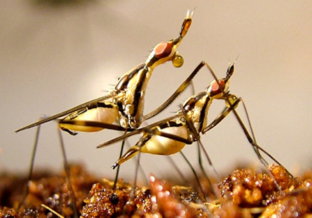Male reproductive output can be limited by sperm production in that frequent mating can decrease sperm stores in many species. This can result in a decrease in fertilisation potential and in offspring sired. However, other costs of frequent mating to male reproductive performance are often overlooked, including trans-generational paternal effects on offspring viability and condition.
Proteins and peptides found in the ejaculate can influence male reproductive performance by affecting fertilisation success and by altering female physiology to increase reproductive output and paternity share. It has also been demonstrated that components in the ejaculate likely influence trans-generational paternal effects on offspring viability and condition. It has been shown in a number of species that these seminal fluid components as well as sperm can be depleted due to frequent mating. Therefore, it could be expected that paternal effects on offspring viability and condition as well as offspring number would be reduced due to frequent mating.
 Male neriid fly guarding a female after copulation. Photo: Russell Bonduriansky.
Male neriid fly guarding a female after copulation. Photo: Russell Bonduriansky.
We used a species of neriid fly (Telostylinus angusticolis) where pronounced paternal effects on offspring viability and condition due to male environment have been demonstrated. In this species, high condition fathers reared on nutrient-rich larval diets produce high condition offspring, and low condition fathers from nutrient-poor larval diets produce low condition offspring regardless of offspring larval diet. Paternal environment and age has also been demonstrated to influence the likelihood of offspring reaching adulthood. If these paternal effects are costly and influenced by a depletable component of the ejaculate, we would expect to see a decrease in paternal effects on offspring viability and condition when these components of the semen are exhausted.
Males were mated frequently (more frequently than the number of matings used to measure decreases in performance of similar species) or kept as virgins and then mated to focal females. Number of matings, egg output, offspring-to-adult viability and offspring size (condition) were recorded. Testis size (used as a proxy for sperm number) and accessory gland size (used as a proxy for seminal fluid protein quantity) was also measured.
While we found that previously mated males mated fewer times with focal females compared to virgin males, we did not find any difference in the number of eggs that females laid, the viability of the offspring or any differences in offspring condition. However, we did find that males that mated more frequently had significantly smaller accessory glands, indicating a potential decrease of accessory gland products with each successive mating. We also found that smaller accessory glands resulted in lower offspring viability.
These results suggest that males of this species are able to mate more frequently than males of similar species and yet suffer no obvious cost to reproductive performance. However, we did find tentative evidence that accessory gland products can affect offspring viability and these may be depleted with increased mating number suggesting that there may be a subtle trans-generational cost in this species, and that these costs may be reduced due to changes in male mating behaviour.
Contributed by Erin Macartney, PhD candidate at UNSW.